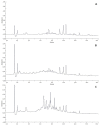Antiviral and Antibacterial Effect of Honey Enriched with Rubus spp. as a Functional Food with Enhanced Antioxidant Properties
- PMID: 35956811
- PMCID: PMC9370118
- DOI: 10.3390/molecules27154859
Antiviral and Antibacterial Effect of Honey Enriched with Rubus spp. as a Functional Food with Enhanced Antioxidant Properties
Abstract
The aim of this study was to investigate the effect of blackberry and raspberry fruits (1 and 4%) and leaves (0.5 and 1%) on the biological activities of rape honey. Honey and plant material extracts were analyzed regarding total phenolic, flavonoid, anthocyanin contents, HPTLC and HPLC polyphenol profiles, as well as antioxidant activity. The antiviral potential was analyzed against bacteriophage phi 6-a coronavirus surrogate-whereas antimicrobial was tested against S. aureus and E. coli. Blackberry extracts were more abundant in antioxidants than raspberry extracts, with better properties found for leaves than fruits and for cultivated rather than commercial plants. The addition of both Rubus plant additives significantly increased the antioxidant potential of honey by four-fold (for 4% fruits additive) to five-fold (for 1% of leaves). Honey with the addition of fruits possessed higher antiviral potential compared with raw rape honey (the highest for 4% of raspberry fruit and 1% of blackberry leaf additive). Honey enriched with Rubus materials showed higher antibacterial potential against S. aureus than rape honey and effectively inhibited S. aureus biofilm formation. To summarize, honey enriched with Rubus fruit or leaves are characterized by increased pro-health value and can be recommended as a novel functional food.
Keywords: Rubus; antibacterial; antioxidants; antiviral; blackberry; fruit; honey; leaves; raspberry.
Conflict of interest statement
The authors declare no conflict of interest.
Figures









Similar articles
-
The enrichment of honey with Aronia melanocarpa fruits enhances its in vitro and in vivo antioxidant potential and intensifies its antibacterial and antiviral properties.Food Funct. 2021 Oct 4;12(19):8920-8931. doi: 10.1039/d1fo02248b. Food Funct. 2021. PMID: 34606549
-
[Comparison of the antioxidant properties of selected parts of raspberry (Rubus idaeus) and blackberry (Rubus fruticosus)].Pomeranian J Life Sci. 2016;62(4):52-9. Pomeranian J Life Sci. 2016. PMID: 29537790 Polish.
-
Chemical Composition, Antioxidant and Antimicrobial Activity of Raspberry, Blackberry and Raspberry-Blackberry Hybrid Leaf Buds.Molecules. 2021 Jan 10;26(2):327. doi: 10.3390/molecules26020327. Molecules. 2021. PMID: 33435253 Free PMC article.
-
Rubus fruticosus L.: constituents, biological activities and health related uses.Molecules. 2014 Jul 28;19(8):10998-1029. doi: 10.3390/molecules190810998. Molecules. 2014. PMID: 25072202 Free PMC article. Review.
-
Rubus occidentalis: The black raspberry--its potential in the prevention of cancer.Nutr Cancer. 2016;68(1):18-28. doi: 10.1080/01635581.2016.1115095. Epub 2015 Dec 23. Nutr Cancer. 2016. PMID: 26699735 Review.
Cited by
-
Untapped potential of non-conventional rubus species: bioactivity, nutrition, and livelihood opportunities.Plant Methods. 2023 Oct 27;19(1):114. doi: 10.1186/s13007-023-01094-y. Plant Methods. 2023. PMID: 37891607 Free PMC article. Review.
-
Exploring Consumers' Preferences and Attitudes to Honey: Generation Approach in Slovakia.Foods. 2023 May 10;12(10):1941. doi: 10.3390/foods12101941. Foods. 2023. PMID: 37238759 Free PMC article.
-
Honey Enriched with Additives Alleviates Behavioral, Oxidative Stress, and Brain Alterations Induced by Heavy Metals and Imidacloprid in Zebrafish.Int J Mol Sci. 2024 Oct 31;25(21):11730. doi: 10.3390/ijms252111730. Int J Mol Sci. 2024. PMID: 39519279 Free PMC article.
-
Preparation of Functional Food with Enhanced Antioxidant Properties by Adding Aronia melanocarpa Polyphenol Honey.Foods. 2024 Nov 28;13(23):3852. doi: 10.3390/foods13233852. Foods. 2024. PMID: 39682923 Free PMC article.
-
The comparison of the antioxidant, antibacterial and antiviral potential of Polish fir honeydew and Manuka honeys.Sci Rep. 2024 Dec 28;14(1):31170. doi: 10.1038/s41598-024-82429-0. Sci Rep. 2024. PMID: 39732871 Free PMC article.
References
-
- Natarajan T.D., Ramasamy J.R., Palanisamy K. Nutraceutical potentials of synergic foods: A systematic review. J. Ethn. Food. 2019;6:27. doi: 10.1186/s42779-019-0033-3. - DOI
-
- Çakiroğlu F.P., Uçar A. Consumer attitudes towards purchasing functional products. Prog. Nutr. 2018;20:257–262. doi: 10.23751/pn.v20i2.5859. - DOI
-
- Pohorecka K. Effect of standardized plant herb extracts on general condition of the honeybee (Apis mellifera L.) Bull. Vet. Inst. Pulawy. 2004;48:415–419.
-
- Socha R., Juszczak L., Pietrzyk S., Fortuna T. Antioxidant activity and phenolic composition of herbhoneys. Food Chem. 2009;113:568–574. doi: 10.1016/j.foodchem.2008.08.029. - DOI
MeSH terms
Substances
Grants and funding
LinkOut - more resources
Full Text Sources
Miscellaneous

